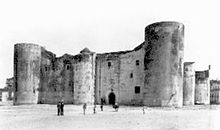Home - In and around
An apartment on the second floor of an ancient palace, is the abode where Verga spent his childhood and lived for long periods surrounded by family and close friends. After the death of Patriarch Giovannino Verga, heir of the writer, the house was bought by the Sicilian Region and open to the public after restoration.
Inside it is kept the furniture and books that belonged to Giovanni Verga. Among the over 2600 volumes include works by Giacosa, Oriani, Rod, Capuana, Di Giacomo, Deledda, Marinetti, Borgese, Villaroel, as well as Russian and French writers such as Turgenev, Dostoevsky, Tolstoy, Gorky, Flaubert, Maupassant, Dumas, Zola.
After the death of the writer, several decades later, in S. Anna she was found because of Verga's pioneer interest in photography.
The sheets and films (now collected in a private collection) reveal a documentary interest, even if by chance, does not go to far from realistic.
The photographs depict mostly familiar faces to the writer: his mother, brothers, uncles, nephews, but also the farmers who work for the family Verga, in Tebidi campaigns, Vizzini. The interest in photography (technique in the second half of the middle class intellectuals involved in a hobby, for its time, very elite) accomunò Verga, Capuana and De Roberto, making them architects of experimentation not without interest.
Giovanni Verga, novelist and short story writer is one of the greatest representatives of Italian realism or naturalism. His early novels are published in a literary climate still heavily influenced by Manzoni and Scott's production and the theories of French naturalism, which are also found support among writers of our country. Verga and Capuana were considered capiscuola of realism: the Capuana is credited with having developed the theory of impersonality and objectivity, but surely belong to the most significant works of Verga realist season, works not always easy to understand for time readers. The characters Verga (fishermen, farmers, artisans) move in a world little known to most people, characterized by strong regionalist aspects and a language that opens new syntactic patterns and does not disdain the use of slang expressions. Despite initial concerns of the time critical, the Verga's novels are still part of the literary memories of each of us and, translated into all languages, was represented in the best theaters and has fascinated the cinema with unforgettable characters.
by region Sicily cultural heritage site
photo castle Ursino
BIRTHPLACE OF GIOVANNI VERGA CATANIA
An apartment on the second floor of an ancient palace, is the abode where Verga spent his childhood and lived for long periods surrounded by family and close friends. After the death of Patriarch Giovannino Verga, heir of the writer, the house was bought by the Sicilian Region and open to the public after restoration.
Inside it is kept the furniture and books that belonged to Giovanni Verga. Among the over 2600 volumes include works by Giacosa, Oriani, Rod, Capuana, Di Giacomo, Deledda, Marinetti, Borgese, Villaroel, as well as Russian and French writers such as Turgenev, Dostoevsky, Tolstoy, Gorky, Flaubert, Maupassant, Dumas, Zola.
After the death of the writer, several decades later, in S. Anna she was found because of Verga's pioneer interest in photography.
The sheets and films (now collected in a private collection) reveal a documentary interest, even if by chance, does not go to far from realistic.
The photographs depict mostly familiar faces to the writer: his mother, brothers, uncles, nephews, but also the farmers who work for the family Verga, in Tebidi campaigns, Vizzini. The interest in photography (technique in the second half of the middle class intellectuals involved in a hobby, for its time, very elite) accomunò Verga, Capuana and De Roberto, making them architects of experimentation not without interest.
Giovanni Verga, novelist and short story writer is one of the greatest representatives of Italian realism or naturalism. His early novels are published in a literary climate still heavily influenced by Manzoni and Scott's production and the theories of French naturalism, which are also found support among writers of our country. Verga and Capuana were considered capiscuola of realism: the Capuana is credited with having developed the theory of impersonality and objectivity, but surely belong to the most significant works of Verga realist season, works not always easy to understand for time readers. The characters Verga (fishermen, farmers, artisans) move in a world little known to most people, characterized by strong regionalist aspects and a language that opens new syntactic patterns and does not disdain the use of slang expressions. Despite initial concerns of the time critical, the Verga's novels are still part of the literary memories of each of us and, translated into all languages, was represented in the best theaters and has fascinated the cinema with unforgettable characters.
by region Sicily cultural heritage site
photo castle Ursino



